Education Indicators in Canada: An International Perspective 2017
Chapter D
The learning environment and organization of schools
Archived Content
Information identified as archived is provided for reference, research or recordkeeping purposes. It is not subject to the Government of Canada Web Standards and has not been altered or updated since it was archived. Please "contact us" to request a format other than those available.
D1 Instruction time
Context
This indicator examines the amount of time, as established in public regulations, that Canadian students aged 6 to 17 must spend in class. More precisely, this indicator shows the annual number of hours of intended instruction time in the curriculum for students by single age (ages 6 to 17). In addition, instruction time by subject in Primary, lower and upper secondary education is also presented. This information is for Canadian public institutions for the 2016/2017 school year. Data are presented for Canada, and for the provinces and territories.Note 1
Instruction time in formal classroom settings accounts for a large portion of the public investment in student learning and is a central component of effective schooling. The amount of instruction time available to students is the amount of formal classroom teaching they receive and can therefore determine their opportunities for effective learning. It is also central to education policy decision-making. Matching resources with students’ needs and making optimal use of time are major challenges for education policy. The main costs of education are the use and deployment of teacher resources, institutional maintenance and other educational resources. The length of time during which these resources are made available to students is thus an important factor influencing the budget in education.
In combination with the information on teachers’ salaries presented in Indicator D2 and teacher working time in Indicator D3, this indicator on instruction time contributes to the development of a set of key measures for full-time teachers in public institutions that, in turn, contribute to expanding the context for discussion of quality of instruction and understanding certain aspects of education processes.Observations
Intended instruction time by level of education
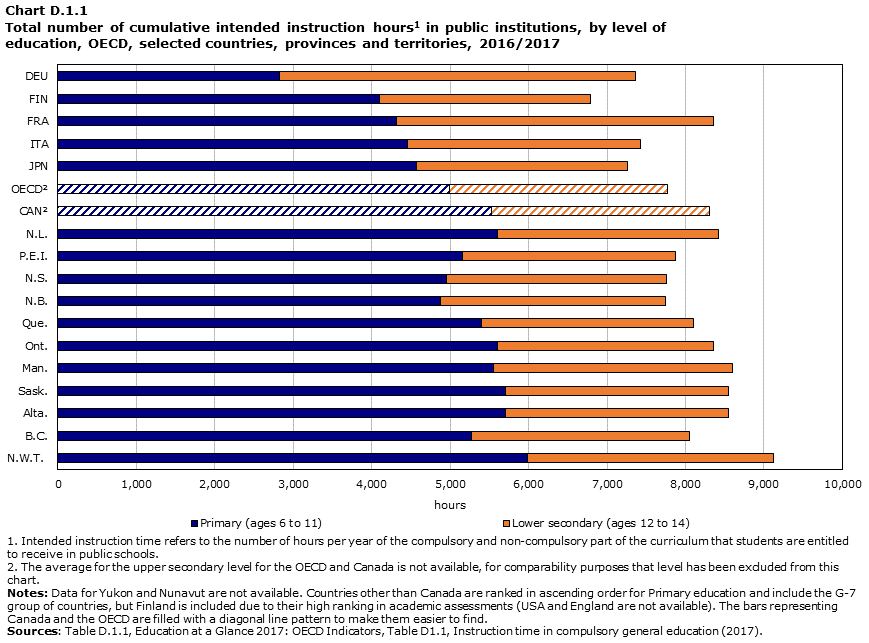
Data table for Chart D.1.1
| Primary (ages 6 to 11) | Lower secondary (ages 12 to 14) | |
|---|---|---|
| hours | ||
| N.W.T. | 5,982 | 3,135 |
| B.C. | 5,268 | 2,782 |
| Alta. | 5,700 | 2,850 |
| Sask. | 5,701 | 2,850 |
| Man. | 5,550 | 3,053 |
| Ont. | 5,610 | 2,750 |
| Que. | 5,400 | 2,700 |
| N.B. | 4,871 | 2,868 |
| N.S. | 4,955 | 2,805 |
| P.E.I. | 5,159 | 2,715 |
| N.L. | 5,610 | 2,805 |
| CANData table Note 2 | 5,521 | 2,790 |
| OECDData table Note 2 | 4,990 | 2,775 |
| JPN | 4,576 | 2,680 |
| ITA | 4,455 | 2,970 |
| FRA | 4,320 | 4,036 |
| FIN | 4,100 | 2,683 |
| DEU | 2,822 | 4,544 |
1. Intended instruction time refers to the number of hours per year of the compulsory and non-compulsory part of the curriculum that students are entitled to receive in public schools.
Sources: Table D.1.1, Education at a Glance 2017: OECD Indicators, Table D1.1, Instruction time in compulsory general education (2017). |
||
- In CanadaNote 2, total cumulative intended instruction time in Primary and Lower secondary education was highest in the Northwest Territories at 9,117 hours. It was lowest in New Brunswick at 7,739 hours.
- The average total cumulative intended instruction time in formal classroom settings for primary level education (ages 6 to 11) and lower secondary level education (ages 12 to 14) was 5,521 and 2,790 hours, respectively.
- In comparison, average total intended time was lower for the OECD countries with 4,990 hours at the primary level and 2,775 hours at the lower secondary level. Instruction time in Primary education in Canada (5,521 hours) exceeded other G7 countries and Finland. While for Lower secondary education, Canada (2,790) only exceeded Japan (2,680) and Finland (2,683).
Definitions, sources and methodology
Data on instruction time are from the 2016 OECD-INES, Eurydice – OECD Instruction Time Data Collection and refer to the 2016/2017 school year. Instruction time for 6- to 17-year-old students refers to the formal number of 60-minute hours per school year organized by the school for class instructional activities in the 2016/2017 reference year. Hours lost when schools are closed for statutory holidays are excluded.
Intended instruction time refers to the number of hours per year during which students receive instruction in the compulsory (this refers to the amount and allocation of instruction time that every public school must provide and all public-sector students must attend) and non-compulsory parts of the curriculum. The total compulsory curriculum comprises the compulsory core curriculum, as well as the compulsory flexible curriculum and non-compulsory parts of the curriculum. Intended instruction time does not include non-compulsory time outside the school day, homework, individual tutoring, or private study done before or after school.
Education is compulsory up to the age of 16 in every Canadian jurisdiction, except for Manitoba, Ontario, New Brunswick and Nunavut, where education is compulsory up to the age of 18.
The average for Canada is calculated by weighting the figures for provinces and territories by the population of children as of July 1, 2016 by single age (6 to 17) in each jurisdiction. All jurisdictions except Yukon and Nunavut are taken into account in the Canada-level average.
| Jurisdiction | Source/Notes on calculation of instruction time |
|---|---|
| Newfoundland and Labrador | The Schools Act sets the minimum instruction hours per day (kindergarten (age 5), 2½ hours; Grades 1 to 12 (ages 6 to 17), 5 hours). The collective agreement between the province and the teachers’ association allows schools to provide up to a maximum of 5 hours of instruction per day for Grades 1 to 3. Compulsory and intended instruction time is 5 hours of instruction time per day multiplied by the number of instruction days (187) in a year. |
| Prince Edward Island | Instruction times for ages 5 to 14 are total minutes per day devoted to a subject multiplied by 181 (the number of instructional days in 2015-2016). Minutes per day for each subject are set in the following provincial documents: Elementary Program of Studies and Authorized Materials, Intermediate Program of Studies and Authorized Materials, and Minister’s Directive No. MD 99-05: Intermediate School Subject Time Allotments. Instruction time for age 15 is based on 8 credits per year at 110 hours per credit as set in Minister’s Directive No. MD 11-02 and the Senior High Program of Studies and Authorized Materials. |
| Nova Scotia | The Ministerial Education Act Regulations set the minimum instruction time per day as 4 hours for Grades 1 to 2 and 5 hours for Grades 3 to 12. Regulated minimum instruction time includes recess for Grades 1 to 6. Compulsory and intended instruction time are calculated based on the minimum instruction time per day (less 15 minutes per day for recess for ages 6 to 11) multiplied by the number of instructional days (187) per year. |
| New Brunswick | Instruction time is based on the minimum number of hours of instruction per day set in the New Brunswick Regulation 97-150 under the Education Act (4 hours per day for kindergarten to Grade 2, 5 hours per day for Grades 3 to 8, 5½ hours per day for Grades 9 to 12). Compulsory and intended instruction time is the minimum instruction time per day, less 20 minutes per day for recess for ages 6 to 10 and 16 minutes per day for flexible scheduling /movement for ages 11 to 15 multiplied by the number of instructional days (185) per year. |
| Quebec | Compulsory and intended instruction time is based on the suggested number of hours for compulsory subjects in elementary and secondary, outlined in the Basic School Regulation for Preschool, Elementary and Secondary Education. |
| Ontario | Ontario Regulation 298 states that the length of the instructional program of each school day for pupils of compulsory school age should be not less than 5 hours a day. This excludes recess and scheduled intervals between classes. For ages 6 to 13, compulsory and intended instruction time is 5 hours of instruction multiplied by 188 instructional days per Ontario Regulation 304. Regulation 304 “School Year Calendar, Professional Activity Days” under the Education Act states that a school year shall have a minimum of 194 school days. In 2014-15, boards could designate up to six of these school days as professional activity days. Any school days not designated as professional activity days were instructional days. Boards may also designate up to 10 instructional days as examination days. In addition, 21 statutory or school holidays are included in the total number of instructional days. On examination days and school/statutory holiday days, instruction would not be provided in Ontario schools. Based on the Ontario Schools, Kindergarten to Grade 12: Policy and Program Requirement, 2011 (OS), for ages 14 to 15, instruction time is based on 8 credits at 110 hours per credit. |
| Manitoba | Manitoba Regulation 101/95 states that the instructional day in a school must be not less than 5.5 hours including recesses but not including the midday intermission. For Grades 1 to 6, the instructional day is 5 hours. For Grades 7 through 12, the instructional day is 5.5 hours. The total compulsory and intended instructional time is the hours of the instructional day multiplied by the average number of 185 instructional days in a school year. |
| Saskatchewan | Time and Credit Allocations - Core Curriculum: Principles, Time Allocations, and Credit Policy (updated June 2011) provides the required minutes per subject per week for each grade.Those were divided by 60 to calculate (to two decimal places) the number of hours per week. The resulting value was multiplied by a factor of 38 (weeks in school year) to obtain hours per year. |
| Alberta | In accordance with section 39(1)(c) of the School Act, the Guide to Education stipulates that schools are required to ensure that Grade 1 to Grade 9 students have access to a minimum of 950 hours of instruction per year in each grade. Schools must also ensure that students in Grades 10 to 12 have access to a minimum of 1,000 hours of instruction per school year. |
| British Columbia | Compulsory and intended instruction time is based on the School Act Regulation that sets the total yearly hours of instruction for students. |
| Northwest Territories | Compulsory and intended instruction time is based on the Northwest Territories Education Act which states that a school day shall consist of no less than 997 hours per year for Grades 1 to 6 and no less than 1,045 hours per year for Grades 7 to 12. |
Note: The corresponding OECD indicator is D1, How much time do students spend in the classroom?
Tables for D1 Instruction time
D2 Teachers’ salaries
Context
This indicator presents annual statutory salaries for teachers at the start of their careers, after 10 years’ experience, and once they have reached the top of the salary scale. These categories reflect salaries for teachers with the most common or typical level of training required for certification in public elementary and secondary educational institutions. All data on these salaries are presented for teachers teaching at the three levels in the International Standard of Classification (ISCED) categories: primary (ISCED 1); lower secondary (ISCED 2); and upper secondary (ISCED 3) education.Note 3
Teachers’ salaries represent the single largest expense in education (see Indicator B3 in this report). A comparison of salary figures at different points reveals some useful information on basic salary structures and the points of salary advancement in a teaching career. Salaries and the accompanying working conditions contribute towards developing, attracting and then retaining qualified teachers. Thus any compensation issue should be a major consideration for policy-makers or others in the education field who want and need to maintain a high quality of instruction while balancing their education budgets. At the same time, any interpretation of international comparisons of teacher compensation, including salaries, should be considered with several other factors in mind. While the salary figures for this particular indicator have taken differences in cost of living for Canada and its fellow OECD countries into account, it is not possible to capture all differences in taxation, social benefits and allowances, or any other additional payments that teachers may receive.
In combination with the information on instruction time and teachers’ working time, presented in Indicators D1 and D3, respectively, this indicator on teachers’ salaries contributes to the development of a set of key measures for full-time teachers in public institutions that, in turn, contributes to expanding the context for discussion of quality of instruction and understanding certain aspects of education processes.Observations
Salaries by ISCED level
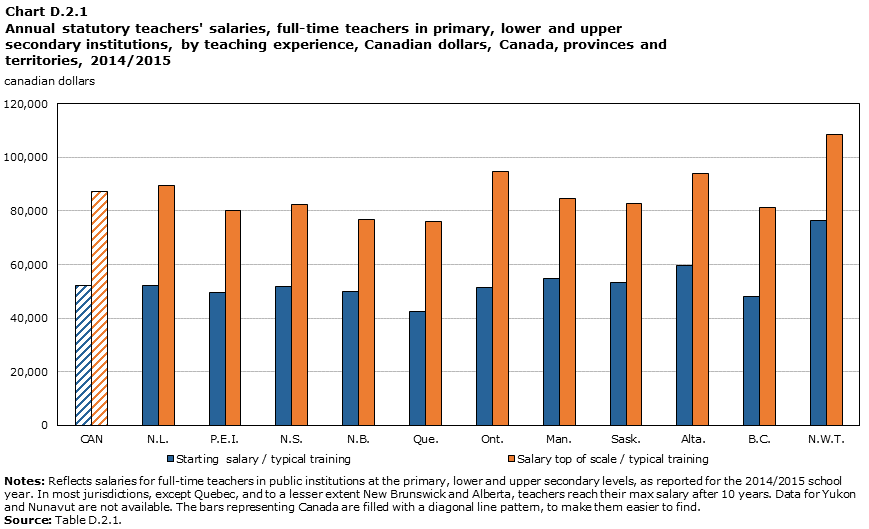
Data table for Chart D.2.1
| Starting salary / typical training | Salary top of scale / typical training | |
|---|---|---|
| canadian dollars | ||
| CAN | 52,064 | 87,202 |
| N.L. | 52,189 | 89,548 |
| P.E.I. | 49,535 | 80,175 |
| N.S. | 51,711 | 82,335 |
| N.B. | 49,774 | 76,753 |
| Que. | 42,407 | 75,956 |
| Ont. | 51,263 | 94,612 |
| Man. | 54,891 | 84,753 |
| Sask. | 53,424 | 82,723 |
| Alta. | 59,488 | 94,103 |
| B.C. | 48,102 | 81,277 |
| N.W.T. | 76,311 | 108,624 |
|
Notes: Reflects salaries for full-time teachers in public institutions at the primary, lower and upper secondary levels, as reported for the 2014/2015 school year. In most jurisdictions, except Quebec, and to a lesser extent New Brunswick and Alberta, teachers reach their max salary after 10 years. Data for Yukon and Nunavut are not available. The bars representing Canada are filled with a diagonal line pattern, to make them easier to find. Source: Table D.2.1. |
||
- In Canada, salaries for full-time teachers in public elementary and secondary schools do not vary across levels of education – teachers are paid the same salaries regardless of whether they are teaching at the primary, lower or upper secondary level.
- By contrast, in many of the countries that recently reported to the OECD, teachers’ salaries tended to rise with the level of education taught (see Table D.2.2).
Salaries throughout career experience
- Starting salaries for full-time teachers in primary, lower and upper secondary institutions averaged $52,064 in Canada, and $87,202 at the top of their salary scales. Typically the top of teacher’s pay scales are around one and a half times their starting salaries, which ranged from $42,407 in Quebec to $76,311 in the Northwest Territories. In comparison, the Canadian average salary in 2015 for all adult (aged 25 to 64) full-time full-year Bachelor’s degree educated workers was $76,834Note 4.
- In Canada, teachers in most provinces/territories reached the top of the salary range at 10 years of experience. This is, in general, sooner than teachers in other OECD countries whose salaries continued to increase beyond 10 and 15 years’ experience.
- In Quebec, teachers did not reach the top of the pay scale until after 15 years’ experience. Unlike other jurisdictions, in Quebec, the salary for 15 years’ experience/top of scale was about $10,740 more than for teachers who had reached the 10-year point on the salary scale.
International comparison of salary levels
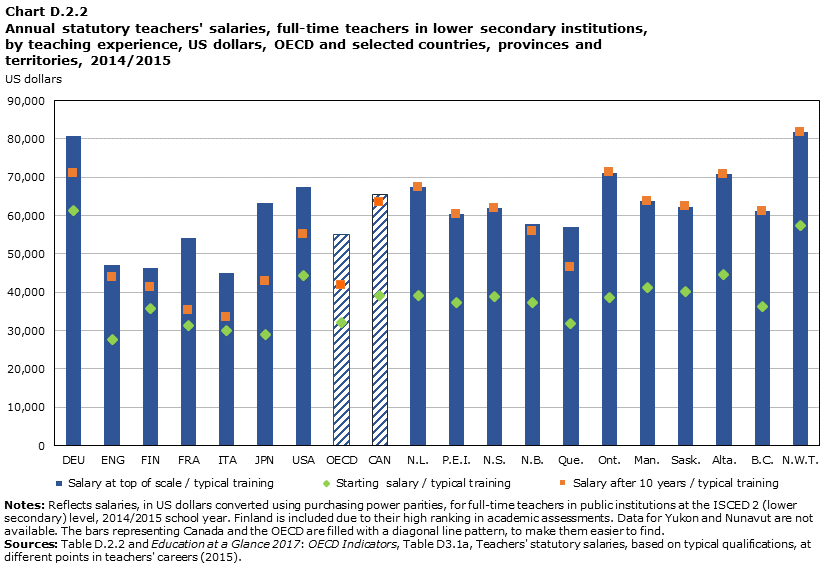
Data table for Chart D.2.2
| Starting salary / typical training | Salary after 10 years / typical training | Salary at top of scale / typical training | |
|---|---|---|---|
| US dollars | |||
| DEU | 61,207 | 71,093 | 80,694 |
| ENG | 27,646 | 43,772 | 47,070 |
| FIN | 35,676 | 41,296 | 46,400 |
| FRA | 31,207 | 35,299 | 54,182 |
| ITA | 30,122 | 33,368 | 45,107 |
| JPN | 29,009 | 42,851 | 63,215 |
| USA | 44,322 | 54,995 | 67,542 |
| OECD | 32,202 | 41,807 | 55,122 |
| CAN | 39,179 | 63,383 | 65,621 |
| N.L. | 39,273 | 67,386 | 67,386 |
| P.E.I. | 37,276 | 60,333 | 60,333 |
| N.S. | 38,913 | 61,959 | 61,959 |
| N.B. | 37,456 | 55,726 | 57,758 |
| Que. | 31,912 | 46,418 | 57,158 |
| Ont. | 38,576 | 71,197 | 71,197 |
| Man. | 41,306 | 63,778 | 63,778 |
| Sask. | 40,203 | 62,251 | 62,251 |
| Alta. | 44,766 | 70,791 | 70,814 |
| B.C. | 36,198 | 61,162 | 61,162 |
| N.W.T. | 57,425 | 81,741 | 81,741 |
|
Notes: Reflects salaries, in US dollars converted using purchasing power parities, for full-time teachers in public institutions at the ISCED 2 (lower secondary) level, 2014/2015 school year. Finland is included due to their high ranking in academic assessments. Data for Yukon and Nunavut are not available. The bars representing Canada and the OECD are filled with a diagonal line pattern, to make them easier to find. Sources: Table D.2.2 and Education at a Glance 2017: OECD Indicators, Table D3.1a, Teachers' statutory salaries, based on typical qualifications, at different points in teachers' careers (2015). |
|||
- Full-time teachers in public institutions in Canada receive higher salaries overall compared with those in most other OECD countries.
- In lower secondary institutions, teachers at the top of their pay scales in Canada had the third highest average salaries ($US 65,621) among the G7 group of countries after Germany ($US 80,694) and the USA ($US 67,542). Within Canada, equivalent teachers in the Northwest Territories ($US 81,741), Ontario ($US 71,197), Alberta ($US 70,814) and Newfoundland and Labrador ($US 67,386) received higher salaries than the Canadian average.
Definitions, sources and methodology
The data on annual statutory teachers’ salaries were derived from the 2016 OECD-INES Teacher’s Salaries and Working Time Survey and reflect the 2014/2015 school year. All information has been reported in accordance with formal policies for public educational institutions.
“Statutory salaries” refer to salaries according to official pay scales and schedules. In Newfoundland and Labrador, Prince Edward Island, Nova Scotia, New Brunswick, Quebec, Saskatchewan, Yukon and the Northwest Territories, the annual statutory salaries are based on 2014/2015 salary scales in collective agreements between each jurisdiction’s teachers’ unions/associations/federations and the provincial or territorial government. In some provinces, however, namely Ontario, Manitoba, Alberta and British Columbia, these pay scales are established at the school-board level and there is no province-wide bargaining.Note 5
The salaries reported are gross (total sum paid by the employer); i.e., they do not include the employer’s contribution to social security and pension (according to existing salary scales). It is gross salary from the employee’s point of view, since it includes the part of social security contributions and pension scheme contributions that are paid by the employees (even if deducted automatically from the employee’s gross salary by the employer). Salaries are “before tax” (before deductions for income taxes). Gross teachers’ salaries are presented in current Canadian dollars, to be compared with the averages for Canada, which were derived from the provincial values (Table D.2.1). The average salary for Canada was calculated as a weighted average of all provinces (the Northwest TerritoriesNote 6, YukonNote 7 and NunavutNote 7 are not included). Weights used depend on the salary calculated. For teachers at the beginning of their careers (starting salaries), the number of full-time educators younger than 30 was used. For teachers with 10 years of experience, the number of full-time educators aged 35 to 44 years was used. And, for teachers with 15 years of experience, as well as those at the top of the salary scale, the number of full-time educators aged 45 or older was used. The Northwest Territories are excluded from the Canada average because the Elementary-Secondary Education Survey (ESES) does not report a breakdown by age for the number of full-time educators. Salaries have also been converted to US dollars (Table D.2.2) using the purchasing power parity (PPP)Note 8 for private consumption from the OECD National Accounts database.
“Starting salaries” capture the scheduled gross salary per year for a full-time teacher with the most common or typical level of training at the beginning of a teaching career. Salaries after 10 and 15 years of experience refer to the scheduled annual salaries of full-time classroom teachers who have the most common or typical training of teachers after 10 or 15 years of experience. The starting salaries and salaries for teachers after 10 and 15 years of experience reported for Ontario differ from other provinces and territories. The figures for Ontario are the midpoint of a range based on the provincially funded grid. They reflect the funded salary assuming the most common level of qualifications among teachers in Ontario at the relevant experience level.
Note: The corresponding OECD indicator is D3, How much are teachers paid?
Tables for D2 Teachers’ salaries
D3 Teachers’ working time
Context
This indicator focuses on the working time and teaching time of teachers in public institutions, by level of education taught, in the 2014/2015 school year. Although working time and teaching time only partly determine teachers’ workloads, they provide valuable insight into the different demands that provinces and territories place on their teachers. Together with teachers’ salaries (see Indicator D2), this indicator describes some key aspects of teachers’ working conditions. Data are presented for Canada, and for the provinces and territories.Note 9
Similar to instruction time for students (see Indicator D1) and teachers’ salaries (see Indicator D2), the amount of time teachers spend teaching has an impact on education budgets. Moreover, teaching hours and the extent of non-teaching duties are major components of the working conditions and may have a direct bearing on the attractiveness of teaching as an occupation.
Of course, teachers also spend part of their working time on activities other than teaching, such as lesson preparation, marking, in-service training and staff meetings.Observations
Teaching time and total working time
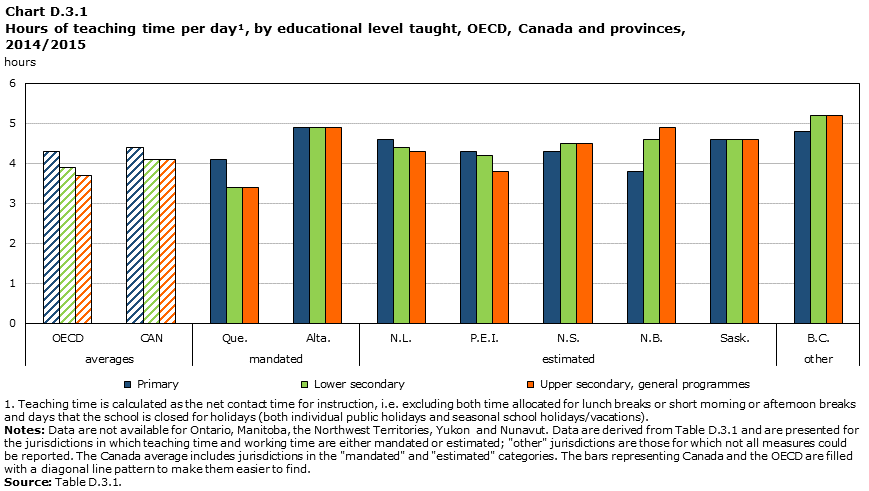
Data table for Chart D.3.1
| Primary | Lower secondary | Upper secondary, general programmes | |
|---|---|---|---|
| hours | |||
| Averages | |||
| OECD | 4.3 | 3.9 | 3.7 |
| CAN | 4.4 | 4.1 | 4.1 |
| Mandated | |||
| Que. | 4.1 | 3.4 | 3.4 |
| Alta. | 4.9 | 4.9 | 4.9 |
| Estimated | |||
| N.L. | 4.6 | 4.4 | 4.3 |
| P.E.I. | 4.3 | 4.2 | 3.8 |
| N.S. | 4.3 | 4.5 | 4.5 |
| N.B. | 3.8 | 4.6 | 4.9 |
| Sask. | 4.6 | 4.6 | 4.6 |
| Other | |||
| B.C. | 4.8 | 5.2 | 5.2 |
|
1. Teaching time is calculated as the net contact time for instruction, i.e. excluding both time allocated for lunch breaks or short morning or afternoon breaks and days that the school is closed for holidays (both individual public holidays and seasonal school holidays/vacations). Notes: Data are not available for Ontario, Manitoba, the Northwest Territories, Yukon and Nunavut. Data are derived from Table D.3.1 and are presented for the jurisdictions in which teaching time are either mandated or estimated; "other" jurisdictions are those for which not all measures could be reported. The Canada average includes jurisdictions in the "mandated" and "estimated" categories. The bars representing Canada and the OECD are filled with a diagonal line pattern to make them easier to find. Source: Table D.3.1. |
|||
- For Canada in 2014/2015, the overall number of teaching hours per day was 4.4 hours for primary education, and slightly less (4.1 hours) for lower secondary and upper secondary education.
- Teaching hours per day in Canada were slightly higher than the OECD averages of 4.3 hours for primary education, 3.9 hours for lower secondary and 3.7 hours for upper secondary education.
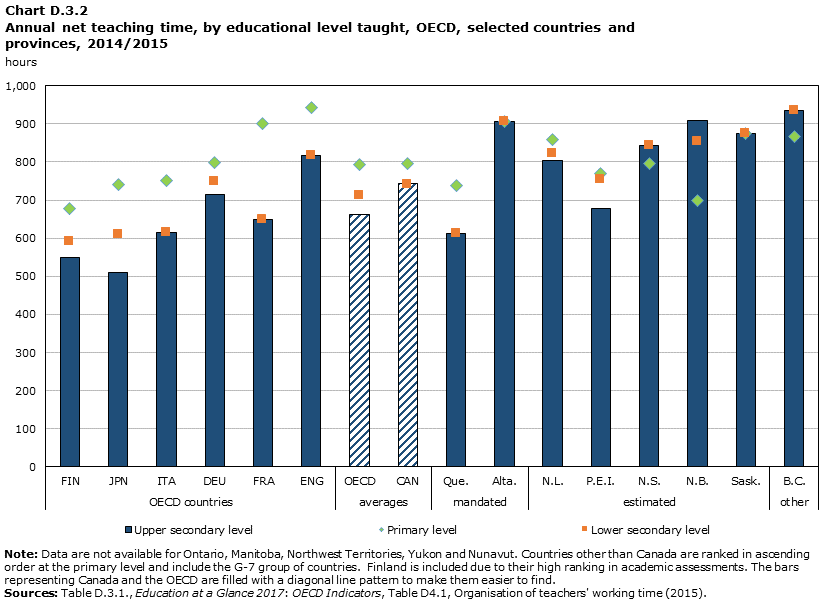
Data table for Chart D.3.2
| Primary level | Lower secondary level | Upper secondary level | |
|---|---|---|---|
| hours | |||
| OECD countries | |||
| FIN | 677 | 592 | 550 |
| JPN | 742 | 610 | 511 |
| ITA | 752 | 616 | 616 |
| DEU | 799 | 750 | 714 |
| FRA | 900 | 648 | 648 |
| ENG | 942 | 817 | 817 |
| Averages | |||
| OECD | 794 | 712 | 662 |
| CAN | 797 | 742 | 743 |
| Mandated | |||
| Que. | 738 | 612 | 612 |
| Alta. | 905 | 905 | 905 |
| Estimated | |||
| N.L. | 860 | 823 | 804 |
| P.E.I. | 769 | 755 | 679 |
| N.S. | 795 | 842 | 842 |
| N.B. | 700 | 854 | 910 |
| Sask. | 874 | 874 | 874 |
| Other | |||
| B.C. | 868 | 934 | 934 |
|
Notes: Data are not available for Ontario, Manitoba, Northwest Territories, Yukon and Nunavut. Countries other than Canada are ranked in ascending order at the primary level and include the G-7 group of countries. Finland is included due to their high ranking in academic assessments. The bars representing Canada and the OECD are filled with a diagonal line pattern to make them easier to find. Sources: Table D.3.1., Education at a Glance 2017: OECD Indicators, Table D4.1, Organisation of teachers' working time (2015). |
|||
- In Canada, primary school teachers taught an average of 797 hours in 2014/2015 compared with the OECD average of 794 hours. Lower secondary school teachers taught an average of 742 hours in 2014/2015, compared with 712 hours for all OECD reporting countries.
- While the upper secondary OECD average (662) of annual net teaching time was significantly lower than annual net teaching time for the lower and primary levels, the Canadian upper secondary average was fairly similar to hours taught at the lower secondary level at 743 hours.
- At the primary level, annual net teaching time varied from 700 hours in New Brunswick to 905 hours in Alberta. These times were in a similar range to Finland and other G7 countries.
- At the lower and upper secondary levels, British Columbia reported the highest annual net teaching time at 934 hours. The lowest amount (612 hours) was reported in Quebec.
- The annual net teaching time in Canada at the lower and upper secondary levels (742 and 743 hours respectively) was most similar to the comparable measure in Germany, but significantly higher than annual net teaching time in Finland, Japan, Italy and France.
- Net teaching time in Finland was included as a comparison because of this country’s high ranking in international academic assessments. Teachers in Finland at the primary (677) and lower secondary (592) levels had a lower net teaching time than all of the G7 countries, Canada included.
Proportion of total working time spent teaching
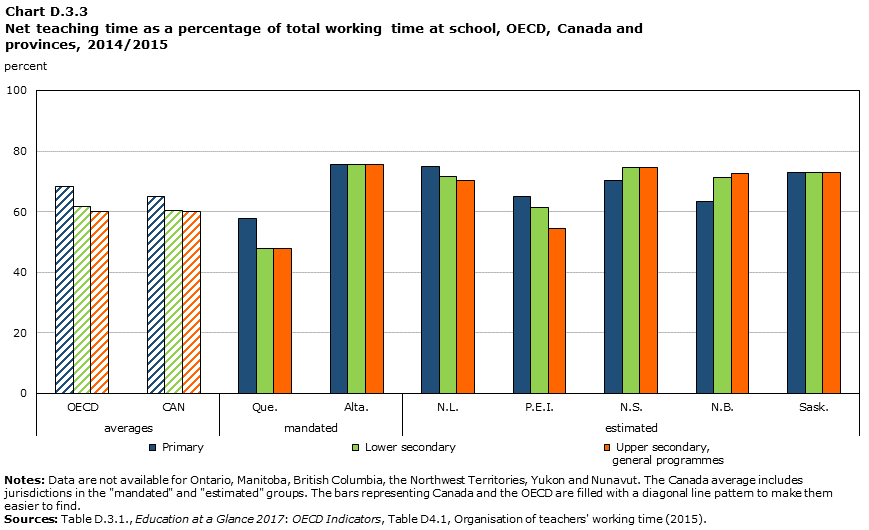
Data table for Chart D.3.3
| Primary | Lower secondary | Upper secondary, general programmes |
|
|---|---|---|---|
| percent | |||
| Averages | |||
| OECD | 68.3 | 61.8 | 60.1 |
| CAN | 64.9 | 60.2 | 60.1 |
| Mandated | |||
| Que. | 57.7 | 47.8 | 47.8 |
| Alta. | 75.4 | 75.4 | 75.4 |
| Estimated | |||
| N.L. | 75.0 | 71.7 | 70.1 |
| P.E.I. | 65.1 | 61.3 | 54.4 |
| N.S. | 70.3 | 74.4 | 74.4 |
| N.B. | 63.4 | 71.4 | 72.6 |
| Sask. | 72.8 | 72.8 | 72.8 |
|
Notes: Data are not available for Ontario, Manitoba, British Columbia, the Northwest Territories, Yukon and Nunavut. The Canada average includes jurisdictions in the "mandated" and "estimated" groups. The bars representing Canada and the OECD are filled with a diagonal line pattern to make them easier to find. Sources: Table D.3.1., Education at a Glance 2017: OECD Indicators, Table D4.1, Organisation of teachers' working time (2015). |
|||
- In Canada in 2014/2015, the proportion of net teaching time to total working time (64.9% for primary, 60.2% for lower secondary and 60.1% for upper secondary) was fairly similar to the OECD averages (68.3% primary, 61.8% for lower secondary and 60.1% for upper secondary).
- Time spent teaching as a proportion of total working time varied widely from one province or territory to another. In 2014/2015, at the lower and upper secondary levels, the proportion of working time spent teaching ranged from 48% in Quebec to 75% in Alberta.
Definitions, sources and methodology
These data are from the OECD-INES 2016 Survey on Teacher’s Salaries and Working Time and refer to the 2014/2015 school year.
All jurisdictions reported instruction time in weeks and days. The “number of weeks of instruction” and the “number of days of instruction” exclude the days per school-year the school is closed for holidays (public holidays and seasonal school holidays).
Only Quebec and Alberta reported statutory working time. For those two reporting jurisdictions, the figures for net teaching time required at school are set in provincial/territorial regulation or collective agreement with the provincial/territorial teachers’ union/association/federation. The remaining jurisdictions reported estimated teaching time of teachers based on the mandated instruction time set in regulation, legislation or collective agreement in each jurisdiction.
“Net teaching time” refers to the number of hours per day or hours per year that a full-time teacher teaches a group or class of students, as determined by policy. It excludes time spent outside of the classroom for non-teaching activities, such as lesson preparation, correction, in-service training and staff meetings. Net teaching time in hours per year is normally calculated as the number of teaching days per year multiplied by the number of hours a teacher teaches per day (excluding periods of time formally allowed for breaks between lessons or groups of lessons). At the primary level, short breaks between lessons are included if the classroom teacher is responsible for the class during those breaks. Apart from Quebec and Alberta, net teaching time was estimated by subtracting from mandated instruction time (as defined in Indicator D1), time allowed for teachers during the school day for marking and preparation as well as recess, if the latter was included in instruction time and if supervision of children was not mandatory.
“Working time required at school” represents the normal working hours of a full-time teacher. Working time may include the time spent specifically on teaching and the time devoted to teaching-related activities required at school, such as lesson preparation, counselling students, correcting homework and tests, professional development, meetings with parents, staff meetings and general school duties. Working time does not include paid overtime. In jurisdictions for which working time is not mandated, working time was estimated by adding supervision time, time for meetings and time for professional development to mandated instruction time.
“Total statutory working time” is the time that teachers are required to spend at work, including teaching and non-teaching time, as specified in regulation or collective agreements.
For all variables, the Canada level average is weighted by the number of full-time educators, for all levels of education combined,Note 10 for all jurisdictions who submitted figures for both teaching time and working time.
Note: The corresponding OECD indicator is D4, How much time do teachers spend teaching?- Date modified:
